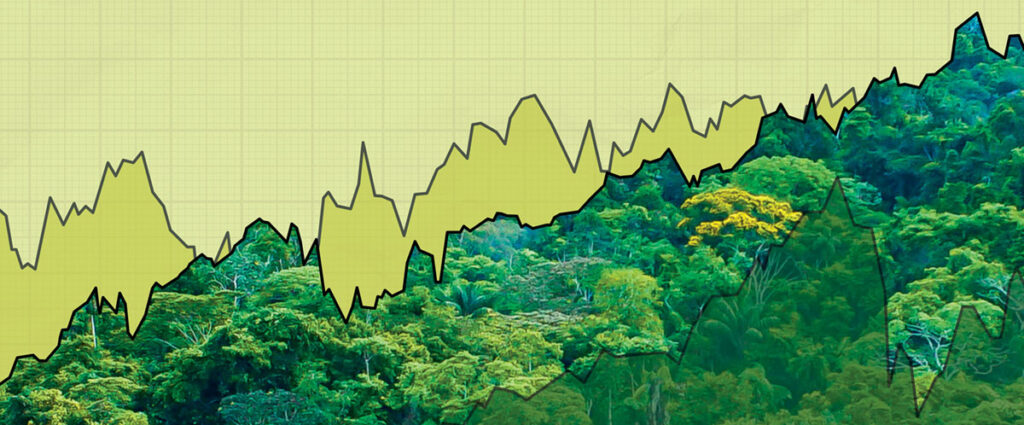
“Would you like to buy a share in Mother Nature?”
That, in a nutshell, is the pitch for “NACs”—or natural asset companies. These publicly traded companies would acquire portfolios of forests, wetlands, savannas, coastal waters, or other ecosystems. Rather than cutting trees, draining wetlands, grazing prairies, or fishing in bays or estuaries to earn profits for their shareholders, NACs would market the values that arise when natural habitats are preserved or restored: carbon sequestration, biodiversity protection, clean water, or other sustainably supplied or nonconsumptive goods and services.
NACs have been in the news. In the fall of 2023, the New York Stock Exchange filed a proposal with the Securities and Exchange Commission to formalize NACs as a new class of public corporation. Working with the Intrinsic Exchange Group, a financial services company that seeks to promote investments in conservation, the NYSE proposed standards for these new companies. As listed entities on the NYSE, NACs would be able to market securities on a financial exchange on which trillions of dollars worth of investments are traded.
It’s not clear there’s an adequate primary market for the goods and services these companies might offer by conserving ecosystems and the benefits they provide.
Those plans fell through earlier this year. The proposal was withdrawn in mid-January after encountering what The New York Times characterized as “a wave of fierce opposition from right-wing groups and Republican politicians, and even conservationists wary of Wall Street.” The scuttling of the proposal didn’t diminish interest in NACs, though. The paper of record still devoted a 2,000-word article to them, noting that the Intrinsic Exchange Group was now seeking to prove the NAC concept in private markets rather than on a publicly traded exchange.
Despite the faltering regulatory start for NACs, corporations with pecuniary interests in conserving nature are coming into being. Are they likely to achieve their financial and conservation objectives?
I have some concerns. I am an economist who has thought and written about biodiversity conservation for 30 years. Over that time I’ve seen many would-be conservation silver bullets and green get-rich-quick schemes announced to great fanfare, only to disappear with little to show after a few years. This would be frustrating enough if it were simply that good-faith efforts had been tried and failed. Too often, though, grand plans were drafted from false premises.
I am, then, a bit apprehensive. I suspect that the premise underlying NACs is faulty: I doubt that allowing investors to buy shares in conservation projects will accomplish much on its own. The problem isn’t that people can’t buy shares of nature-based assets in a secondary market. The problem, rather, is that it’s not clear there’s an adequate primary market for the goods and services these companies might offer by conserving ecosystems and the benefits they provide.
Some Economics of NACs
The basic idea of investing in nature is certainly a sound one. Economists argue that assets should be devoted to their “highest and best use”—which, in the case of natural resources, sometimes may be for non-consumptive or non-use purposes. If conservationists are willing to pay more to preserve natural resources than others are to consume them, the resources should be conserved.
There are good reasons for conservationists to band together to preserve natural resources. Conservation may require large investments. The sums of money necessary to protect large tracts of land may be beyond the means of individuals who care about protecting nature but don’t have millions of dollars at their disposal. A NAC could be a vehicle for combining small contributions into a more substantial combined payment for conservation. Again, this would be a desirable outcome.
If the chief function of NACs is to aggregate and channel funding for conservation, though, it’s worth asking how they would differ from existing nonprofit organizations. After all, conservation groups such as PERC, The Nature Conservancy, and the National Wildlife Federation routinely raise funds for conservation projects, along with many other similar organizations operating at local, regional, and global scales. The obvious answer is that NACs might attract funding not only from conservationists who want to “do good” by saving nature, but also from investors who see preserving natural assets as a way to “do well” by making a positive return on investment.
As I’ll argue, though, opportunities for profitable investment in ecologically benign ventures may be rare, limited, or highly speculative because of the difficulty of translating conservation benefits into reliable income. This means investors in NACs would be “betting on the come”—that is, putting their money into ventures whose success depends on as-yet-unknown market developments.
Therefore, investments in natural assets are likely to be risky, and even wealthy investors probably won’t want to put too many of their eggs into a single basket. Under a NAC, ownership could be divided among large numbers of shareholders who could expand or liquidate their holdings to maximize returns and manage risks. A NAC might, then, provide opportunities for diversifying risks and attract more total conservation investment than would a more closely held enterprise.

A Category Error?
I’ve just noted a few reasons why offering shares in NACs might be useful in financing conservation. Yet, in my experience, the problem with drawing private investment into conservation isn’t so much the lack of an active secondary market in stocks and bonds for nature-based companies. It’s that there may not be an adequate primary market for the goods and services these companies might offer through the conservation of ecosystems and their benefits. I suspect from documents I’ve read and conversations I’ve had that some proposals to launch NACs commit a “category error” of logic: They fail to appreciate the fundamental distinction between private and public goods.
The value of a share of stock is determined by the flow of profits the underlying company is expected to realize over time. The stock of Apple, to give an example, is worth over $2.5 trillion. That value is determined by how many iPhones, MacBooks, and other products Apple is expected to sell. The company would not be worth anywhere close to $2.5 trillion if anyone who wanted to could walk out of an Apple Store with an iPhone or MacBook without paying for it. In economic parlance, Apple is worth so much because it sells private goods for which there is robust demand. The owner of a private good enjoys its benefits and can prevent others from enjoying those benefits without paying. This is in contrast to a public good, which, when it is provided by one person, is also enjoyed by others who cannot be prevented from sharing in the benefits and cannot be compelled to pay for them.
Natural ecosystems may provide both private and public goods. For example, honey collected from bee colonies in forested areas might be sold to consumers who enjoy it themselves; moreover, carbon sequestered from the same forests may provide climate moderation benefits around the world. Despite decades of research and experimentation, however, there simply doesn’t seem to be enough demand for the private goods and services generated by diverse natural ecosystems to finance conservation on the scale envisioned by, for example, the Biden administration’s “30 by 30” initiative to protect 30 percent of terrestrial and marine habitats by 2030.
That’s been one painful lesson: Some highly touted values of biodiversity simply haven’t been shown to be worth much.
For decades, advocates have tried to marshal sales of ecosystem-related private goods to finance conservation. Let me give an example of one of the more high-profile failures. When I began working on resource economics in the early 1990s, there was a burst of enthusiasm for “bioprospecting”—commercializing biodiversity for new pharmaceutical research. Nature, it was argued at the time, is a virtually limitless warehouse of novel molecular research leads. If drug companies purchased rights to test natural products for their therapeutic potential, new products would be discovered, the poor tropical nations in which biological diversity tends to be greatest would have a new source of income, and incentives for maintaining tropical forests would be greatly strengthened. It would be a win-win-win. Colleagues and I realized, however, that there’s a problem with this formulation. How much would drug companies pay to maintain more shelves in a “virtually limitless” warehouse of samples? “Not much,” was the answer we got when we did the calculations. Economic value arises from scarcity, and pharmaceutical researchers did not regard prospective leads as scarce. Researchers already had millions of different species to experiment with, as well as a multitude of inorganic and synthetic materials; they simply weren’t willing to pay much for access to still more potential research leads. Sadly, this finding has been borne out by dwindling interest in bioprospecting over the intervening decades.
That’s been one painful lesson: Some highly touted values of biodiversity simply haven’t been shown to be worth much. Diverse natural ecosystems give rise to a host of other values, though: pollination, pest control, groundwater recharge, water purification, storm protection. A sort of good news/bad news story has often emerged from the work that I and a number of other researchers have done on these values. The good news is that some ecosystems supplying such services may be quite valuable, which may provide straightforward business propositions for NACs. The water purification services of natural wetlands might, for example, obviate the expenditure of millions of dollars on a treatment plant. The bad news is that such services may be most valuable when we don’t need to preserve a lot of habitat to provide them. I’ve referred to this idea as a “paradox of efficiency”: If a little goes a long way, we don’t need a lot. Natural wetlands can be very effective in treating water pollution, but they are most cost-effective when a small area of habitat can provide the service. If a small area of habitat cannot efficiently treat pollution, however, building a treatment plant may be less expensive than setting aside larger areas for the purpose. This suggests that NACs may not be all that effective at motivating conservation at scale, especially relative to existing philanthropic efforts.

Vast Value?
This brings us back to the key question of how NACs will generate shareholder value. Private goods and services are those for which specific beneficiaries are identifiable and willing to pay. Unless they can find better ways to generate income than past efforts to commercialize bioprospecting, ecotourism, non-timber forest product collection, pollination provision, water purification, and similar ventures, then there seems little reason to suppose that NACs will achieve greater success. Earlier ventures didn’t disappoint for want of financing. They disappointed for want of demand—possibly because it’s difficult to leverage the public and private benefits of conservation into sustainable income.
If demands for the private goods and services of natural ecosystems are unlikely to be sufficient to finance the preservation of imperiled habitats, could the value of public goods provided by diverse natural ecosystems tip the balance? Perhaps. The world’s forests contain about 75 times more carbon than is released in annual emissions. The climate moderation provided by maintaining these stores represents a global public good of great value. The same might be said of the biodiversity harbored in the world’s remaining relatively pristine ecosystems. People around the world value the preservation of pandas, lemurs, tigers, and other endangered species. Likewise, scientists warn that key natural systems and processes could flip precipitously, with profound consequences, as landscapes change. How much deforestation may occur before the Amazon rainforest dries and turns to savanna? We can’t be sure, but this is the sort of risk against which humanity might be willing to pay to indemnify ourselves by preserving natural ecosystems.
The public goods provided by diverse natural ecosystems may be worth a vast sum of money, but that doesn’t mean that NACs can expect to sell them for a vast sum of money.
“Humanity,” however, is not a market actor. Writings on NACs often appeal to the astronomical values of global public goods, without closing the loop on how those values translate to sustainable income for NACs. Are the services of nature worth substantially more than all of the iPhones and MacBooks that Apple will ever sell? Quite possibly. The public goods provided by diverse natural ecosystems may be worth a vast sum of money, but that doesn’t mean that NACs can expect to sell them for a vast sum of money. NACs may help augment the supply of natural assets, but the scale and success of conservation will ultimately be determined by demand. The real key is for environmentally minded entrepreneurs to find innovative ways to generate greater payments for the public and private benefits of conservation.




